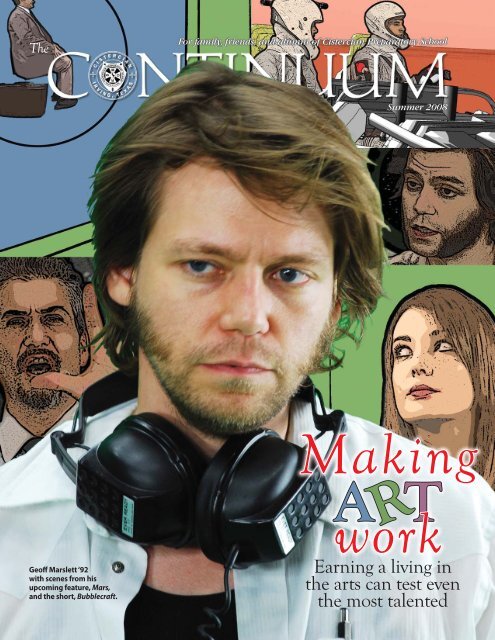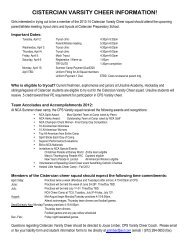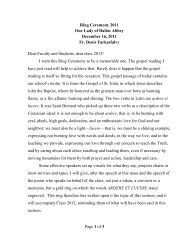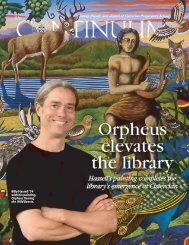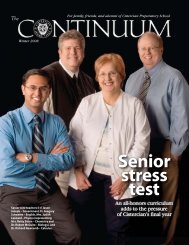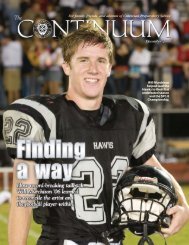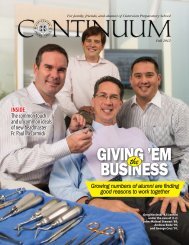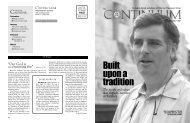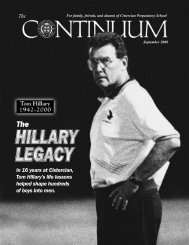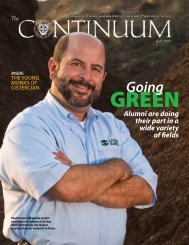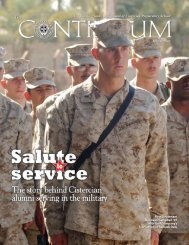Making Art Work - Cistercian Preparatory School
Making Art Work - Cistercian Preparatory School
Making Art Work - Cistercian Preparatory School
- No tags were found...
You also want an ePaper? Increase the reach of your titles
YUMPU automatically turns print PDFs into web optimized ePapers that Google loves.
TheFor family, friends, and alumni of <strong>Cistercian</strong> <strong>Preparatory</strong> <strong>School</strong>Summer 2008Geoff Marslett ‘92with scenes from hisupcoming feature, Mars,and the short, Bubblecraft.<strong>Making</strong>A TworkREarning a living inthe arts can test eventhe most talented
The Memorare Society was established for members of our communitywho wish to include <strong>Cistercian</strong> in their financial plans throughbequests, trusts, wills, or other means. It’s a wonderful way for peopleto include the school as part of their long-term financial planning.As a member of the Memorare Society, you’ll enable us to continueeducating <strong>Cistercian</strong> students and the Abbey’s young monksfor many years. All while ensuring your legacy with <strong>Cistercian</strong> forgenerations to come. After all, Memorare means “remember.”To find out if the Memorare Society is right for you and your family,simply contact Jennifer Rotter in the Development Office today.All enquiries are welcome. Call 469-499-5406, or send an emailto jrotter@cistercian.org.
CISTERCIANPREPARATORYSCHOOLRev. Peter Verhalen ’73HeadmasterRev. Bernard MartonAssistant HeadmasterGreg Novinski ’82Dean of StudentsRobert J. HaaserDirector of AdmissionsChristine MedailleDirector of StudiesJanet Bucher-LongCollege CounselorJennifer RotterDirector of Developmentand Alumni RelationsDan LeeDirector of AthleticsChris Stewart ’91President, <strong>Cistercian</strong>Alumni Association<strong>School</strong> BoardRt. Rev. Denis FarkasfalvyRev. Roch KeresztyRev. Julius LeloczkyRev. Robert MaguireRev. Bernard MartonRev. Peter Verhalen ’73Joel K. FontenotDavid C. HaleyDr. Robert J. HendersonJames M. Moroney III ’74Peter P. Smith ’74Jere W. Thompson, Jr. ’74The continuumDavid Stewart ’74Editor & <strong>Art</strong> DirectorTom B. PruitCopy EditorJennifer RotterAssistant Copy EditorJim ReischPhotography EditorThe continuum is publishedtwice a year (winter and summer)by <strong>Cistercian</strong> <strong>Preparatory</strong> <strong>School</strong>.3660 <strong>Cistercian</strong> RoadIrving, TX 75039469-499-5400www.cistercian.orgRequired reading for the school yearThis edition will inspire you to pursue your highest ideals and goalsThe best preparation for this school year, I think,is to read this edition of The Continuum fromfront to back. You will find stories to help you setgoals for the year and find the motivation to keepworking toward them.Our cover story, “<strong>Making</strong><strong>Art</strong> <strong>Work</strong>,” shows howsome of our artistic alumniare achieving success, eachin his own way, as they pursuetheir passions and earn aliving.Dr. Pruit’s story capturesLetter fromthe headmasterFr. Peter Verhalen ’73how each year our incredibleteachers, students andfamilies breathe new life intothe <strong>Cistercian</strong>s’ centuries-oldlegacy of enkindling and enlightening.On your own, you’ll find humor throughoutthis issue, but I most enjoyed that of our youngcolumnist, Will Arbery ’07. He pokes a bit of fun atvolume 35, number 2<strong>Making</strong> art work 8<strong>Cistercian</strong> alumni are finding waysto express their creative passionsin a wide variety of fields. Whythey do it and who might hit it big.By David StewartDarryl Ratcliff II ’04Enkindled &enlightened 14The Class of 2008 produced lotsof leaders. Three among them,with constant support from theirparents, personify <strong>Cistercian</strong>’smission. By Tom Pruithimself, while contemplating the transition fromhome and <strong>Cistercian</strong> to college.Most importantly, however, this edition of TheContinuum provides many reasons for gratitude.The remodeling of the Upper <strong>School</strong> is comingto a completion. Students are winning awards,earning acceptances to wonderful colleges, postingpersonal bests in a final track meet.Alumni are starting, and growing, their families.Under the direction of Joseph Shea ’78, alumniare collecting contributions to endow a scholarshipin honor of their form master, Fr. Roch.They are serving in combat in the Middle East.And we are all most grateful for the recovery ofSmokey Briggs ’84 from his surgery.I do hope that this issue will motivate you to setyour goals high and to continue striving for them,to stand back in humble admiration at the goodnessof others, especially our parents and thosewho have preceded us, and to give thanks for themany blessings in our lives.in this issuedepartments<strong>School</strong> News ................................4-7Sports ............................................18Class Notes ..............................19-22Afterthoughts by Will Arbery ’07.......23On Prayer by Fr. Roch Kereszty ..........24Cover photography:courtesy of Geoff Marslett ’92<strong>Cistercian</strong> <strong>Preparatory</strong> <strong>School</strong> was founded with the aim of preparing talented boys for the colleges of their choice bychallenging their minds with excellent academic programs, molding their character through the values of Catholiceducation, and offering them guidance with both understanding and discipline. <strong>Cistercian</strong> <strong>Preparatory</strong> <strong>School</strong> doesnot discriminate on the basis of race, color, national or ethnic origin in the administration of its educational practices,admissions, scholarship programs, and athletic and other school administered programs.Summer 20083
cistercian newsUpper <strong>School</strong>additionsICSI R VTEI N G,5050thFRESH FACES These photos by Jim Reisch(Top, left to show the progress on the additionsto the Upper <strong>School</strong>right): JorgeSantamaria, and the reconfiguration of theJP Walsh, gym’s vestibule, which will nowhouse the Spirit Store, videolab, and publication room. Allconstruction will be complteby the first day of school. Hatsoff to Andres Construction.RCIAT E X A SNFund-raisingDonors generouslygive to all threeschool fundsBetween Sustentation, Phonathon,and the 50th AnniversaryCampaign, donors contributed arecord sum to <strong>Cistercian</strong> in thepast year.The contributions exceededgoals for each of the school’sthree fund-raising efforts.Sustentation, which fundsextraordinary expenses relatedto the physical plant, raised$502,115, breaking the half millionmark for the second consecutiveyear and beating the goalby over $100,000.Phonathon also exceeded itsgoal, bringing in donations forscholarships of $128,185. As istheir custom, 100 percent of theClass of 1983 contributed.Finally, the 50th AnniversaryCampaign raised an astounding$8.5 million of the $15 milliongoal in its first year. The campaignis envisioned as a fouryearproject.As a result of these outstandinggifts, a large-scale renovationand addition to the Upper<strong>School</strong> was made over the summerand was completed in timefor the first day of school (seephotos at left).The Middle <strong>School</strong> renovationis already scheduled to startain 2009.“The 50th Anniversary Campaignis fulfilling our dreams,”said Fr. Peter Verhalen ’73.“At every turn during the Upper<strong>School</strong> renovation, we haveopted for the more beautiful,more lasting alternative.“The renovated version remainstrue to the O’Neill Fordinspiration,” he added, “ yet it isenergy efficient, attractive, andup-to-date.“It will last us another 50years.”4 The Continuum
College destinationsNew scholarshipshelp Class of ’08 hitprestigious targetsThe Class of 2008 will, nodoubt, be remembered as one ofthe brightest and most decoratedclasses in <strong>Cistercian</strong>’s first 50years.It may also lay claim to the titleof “Most Fortunate” as well.On December 10, 2007,Harvard announced the mostsignificant middle-class scholarshipprogram in recent collegehistory.A large number of universitiessoon followed suit.Before 2004, Harvard —along with many of the highestpriceduniversities — would paythe entire tuition for a studentwhose family earned $30,000or less.Then, over a three-year period,the income-level was raisedto $40,000 and then to $60,000.Nevertheless, “a hugemiddle-class gap in the demographicprofile of the incomingclasses was developing,” saidNash Flores, Harvard’s regionaldirector for the State of Texasand co-chair of Harvard’s Dallas<strong>School</strong>s Committee.So, in December, Harvardannounced that students whosefamilies earn between $60,000and $180,000 will be required topay only 10 percent of their annualincome.“The number of applicationsrose 20 percent this year,” Floresnoted. But despite the increasedcompetition, five <strong>Cistercian</strong> studentswere accepted to Harvard,and four are attending“I believe this year’sbumper crop for <strong>Cistercian</strong>can be attributedto the increased numberof applications from theschool and Janet Bucher-Long’s long relationshipwith the university,”Flores said.“Peter Smith ’74,Alex Nettune ’94, and Ialso have been workingfor years to encourageClass of 2008 takes to the roadTexas vs. the rest%36%64Texas Out of stateTravelingin groups to ...Harvard ...........................4Notre Dame ....................3Texas A&M ......................3UT Austin ........................3Creighton ....................... 2Furman ........................... 2Northeastern..................2Princeton ....................... 2Rice .................................. 2SMU ..................................2Vanderbilt .......................2COLLEGE DESTINATIONSTraveling solo to ...Arizona State UniversityBaylor UniversityOlin College of EngineeringOklahoma State UniversitySanta ClaraSwarthmoreTCUTexas TechTrinity UniversityUniversity of DallasUniversity of DenverUniversity of PennsylvaniaUniversity of San DiegoUniversity of Southern Cal.UT DallasWake ForestYale Universitycistercian newsthe university to take a longerlook at <strong>Cistercian</strong> students.”The ripple effect — 63 institutionsfollowed Harvard’s lead— made a major impact on thenumber of students deciding toattend college out of state.NUMBERS GAMEClass of 2008(or 64 percent) leaving Texas,28 most in recent history(or 18 percent of class)8 attending Ivy League schoolsattending 10 different16 Texas schoolsattending 28 different44 colleges and universitiesOver the past 10 years, thepercentage of seniors attendingcollege out of state hoveredaround 50 percent or below.Sixty-four percent of theClass of 2008 are attendingschool out of state.In all, eight from the Class of2008 are attending the Ivies.Bryan Hsu ’08 is attendingthe University of Pennsylvaniawhere he’ll combine a businessmanagement degree from theWharton <strong>School</strong> of Businesswith an engineering degree.Co-valedictorian Clay Jiminez’08 also will pursue engineeringat the Olin <strong>School</strong> ofEngineering.Alejandro Torres ’08 becamethe first <strong>Cistercian</strong> student towin a Gates Millenium Scholarshipand Jack Squiers ’08 wasawarded a Presidential Scholarship(see stories on page 6).Connor Heard ’08 was offeredWashington & Lee’s mostgenerous scholarship, but turnedit down to attend Harvard. Likewise,co-valedictorian RichardNewcomb ’08 won the mostprestigious scholarship at RhodesCollege, but will attend Harvard.Summer 20085
cistercian newsPhoto by Jim ReischHeard winsHillary AwardConnor Heard ’08 followedin the footsteps ofbrother Zach Heard ’06 bywinning this year’s HillaryAward. Heard, who is attendingHarvard, played football,basketball, and baseball.The award is given eachyear to the senior who mostexplemifies academic andathletic excellence.Gates Millennium ScholarshipTorres wins lucrativeeducational awardAlejandro Torres ’08 was named <strong>Cistercian</strong>’s first GatesMillennium Scholar (GMS) last spring.The scholarship helps outstanding minority students reachtheir full potential by financing a great deal of future expensesassociated with their education.A renewable award, the Gates scholarship funds a student’sunmet need based on the total cost of attending college, includingtuition, room, board, books, meals, and fees.Gates Millennium Scholars can pursue any field of undergraduatestudy and can receive funding through their doctoraldegrees in fields of study including: computer science, education,engineering, library science, mathematics, public health,and science.Torres plans to pursue a path to medical school.Designed for students of color from lower income families,the program was funded in 1999 by a $1.6 billion grant fromthe Bill and Melinda Gates Foundation.It is especially fitting that Torres would be awarded thisscholarship since he attended <strong>Cistercian</strong> on the Fr. Pascal Kis-Horvath Scholarship funded by the Gates Foundation.Torres is one of nine students from the Metroplex to receivethe scholarship, and one of only three from Dallas (theothers attend Hockaday and St. Mark’s).Alejandro Torres ’08is attending Yale. TheGates Millennium Scholarshipwill help pay forboth his undergraduateand graduate education.Connor Heard ’08Teacher honoredHaaser wins“<strong>Work</strong> of Heart”grand awardThe entire <strong>Cistercian</strong> communityholds Bob Haaser in thehighest esteem. At this year’sClosing Ceremonies, that esteemtook the form of a “<strong>Work</strong>of Heart” Grand Award.The 39-year veteran of <strong>Cistercian</strong>has served in virtuallyevery capacity at the school,save a priest. Yet, he remains asaint in the eyes of many for hisdevotion to <strong>Cistercian</strong>, its students,and its principles.Currently, he leads the Classof 2014 as its form master andteaches social studies and history,while serving in the demandingjob as Director of Admissions.Parents, students, and teachersnominated Haaser for theaward. Haaser’s influence“quakes through his students,years — even decades — afterthey have graduated,” one nominationread.“He inspires and influencesnot only his students and formerstudents, but his students’ familiesas well.”Hawks incombatPlease keep in yourprayers those alumni whoare in harm’s way defendingour country:Nathan Porter ’95Vinnie Sherman ’96Donovan Campbell ’97William Parish ’98Eddie Anderson ’03Gary Darby ’03Robert Reagan ’03** in flight trainingPlease email Carolina Pruitcpruit@cistercian.org to addother alumni to this list.Jack Squiers ’08, who is attendingPrinceton this fall,was named <strong>Cistercian</strong>’s thirdPresidential Scholar.National honorSquiers earnsPresidential Scholaraward for 2008Jack Squiers ’08 was nameda Presidential Scholar in May.He is only the third <strong>Cistercian</strong>student to receive this honor(Jim von der Heydt ’92 andMichael Montoya ’07 precededhim).On June 23, Squiers and theother 138 recipients traveled tothe White House to receive theirgold medals from the Presidentand the Secretary of Education.Squiers becomes the first <strong>Cistercian</strong>student ever to win boththe Presidential Scholarship andthe prestigious Davey O’BrienAward (for scholarship and athletics).Robert Schoenvogel ’95is the only other <strong>Cistercian</strong> studentto win the Davey O’Brien.Squiers is a National MeritSemifinalist and a winner of theSaint Bernard Gold Award.He served as vice president ofthe student council, and playedon the varsity football, swimming,and baseball teams.Five of this year’s PresidentialScholars hail from Texas (twofrom Dallas, one from Austin,and two from the Houston area).Squiers plans to study engineeringat Princeton.Photo by Jim Reisch6 The Continuum
Community serviceCatholic Charitieshonors <strong>Cistercian</strong>students, familiesThe Catholic Charities ofDallas honored <strong>Cistercian</strong> threetimes over at their Volunteer AppreciationDinner in the spring.“As a school,” said Fr. PaulMcCormick, community serviceadvisor, “our students werecelebrated for their generouswork.”At Thanksgiving. studentsstocked the food pantry. AtChristmas, students adoptedfamilies, and, most recently,students assisted with the Thriftstore.Andres Trejo ’11 and AndrewJacob ’13 represented <strong>Cistercian</strong>at the event and accepted theawards.In addition, Mr. and Mrs.Robert Greenfield were recognizedfor the efforts mentoringa refugee family from Burundi,Africa. The Greenfields havegiven their time in mentoringrefugee familes frequently overthe years.The Gerry Jacob family washonored as the Volunteer Familyof the Year in Dallas.Quiz BowlYoung team gainsvaluable experiencein Washington, D.C.The <strong>Cistercian</strong> Varsity QuizBowl Team flew to Washington,D.C. at the end of the schoolyear to participate in the NationalAcademic Challenge.Captain Michael Lawson ’09led the team comprised of AlexHowells ’09, Jonathan Wu ’10,and Arnaud Zimmern ’10.<strong>Cistercian</strong>’s young teamplayed aggressively and managedto win several close matches.The Hawks finished the daywith four wins and two losses.In the championship round,<strong>Cistercian</strong> lost in the singleeliminationformat the next day.“I was very proud of theteam’s strong play,” said Fr.Gregory Schweers. “We lookforward to a superb fall seasonin 2008, with all of our teammembers returning for Varsityplay.”UPPER SCHOOL DRAMASt. Francis resurrected in Scenes from Assisi(Top) Carson Chapman ‘09 stands beforethe tribunal. (Bottom right) BasilKoutsogeorgas ‘08 portrays “the Wolf.”(Inset) Scott Kinard ‘08 as St. Francisconfronts “the Wolf.” (Bottom left) PaulDiFiore ‘09 as St. Francis in his youth.Photos by Jim Reischcistercian newsNo one in the audience failed to graspthe message of Scenes from Assisi, thisyear’s Upper <strong>School</strong> drama, directed byformer <strong>Cistercian</strong> teacher (and current parent)Jonathan Leach.Drawing on Laurence Housman’s TheLittle Plays of St. Francis (1922), Leach— also a <strong>Cistercian</strong> parent — arrangedparts of the author’s work into a five-actformat to tell the story of St. Francis’ life.“The actors wore sweatshirts and thesets (built by Director of Students GregNovinski ’82) were very simple by design,”Leach said. “I wanted the audienceto focus on the overtly religious theme,”In all, four different actors, each wearingorange, played St. Francis to conveySt. Francis’ transformation from fun-lovingyouth to serious saint.The plot turns when St. Francis (PhilipSchnorbach ’08) encounters a leper (BasilKoutsogeorgas ’08).“What stood out,” recalled Leach, “wasthe pain and hatred that Basil conveyed inhis character, and Philip’s initial revulsionand then deep compassion for the leper.”In the final scene, Scott Kinard ’08brought “a real sense of the wrath of God tohis portrayal of St. Francis,” Leach said.Audiences responded emotionally tothe fine performances and the elegant poetryof Housman’s words.The audience and actors also clearlyappreciated Leach’s return to <strong>Cistercian</strong>.Summer 20087
CITY-BOUNDCOUNTRY/CAJUN BANDNick Beaudoing ’92 (front)and the rest of the New YorkbasedDoc Marshalls posefor the cover of their secondalbum, Honest for Once.8 The Continuum
<strong>Making</strong>ARTwork<strong>Cistercian</strong> alumni are finding ways to express their creative passionsin a wide variety of fields. Why they do it and who might hit it big.RBy David E. StewartNick Beaudoing ’92 began peforming at Riley’s Tavernin Hunter, Texas (population: 50) on a cool Tuesdayin April about 9 pm. Only two cowboys, the pooltable, and shuffle board were listening.It had already been a long day on an exhaustingsolo tour for the singer/songwriter.Only a few hours earlier, he had concluded a five-hour trek throughthe Hill Country to three country radio stations where he had giveninterviews and sung songs on the air.About midway through his first set at Riley’s, the lone listenersstepped outside for a few minutes; then the bartender retired to replacea keg. Beaudoing found himself singing for no one except forfour historic walls. 1Such lonely moments can lead any artist to consider the eternalquestion: “Why am I doing this?”For the most part, however, Beaudoing’s success these days leadsto nothing but confidence.Since 2001, he has served as the front man for the honky-tonk/Cajun band, the Doc Marshalls. The fact that they’re based in NewYork City, where country music serves as court jester rather thanking, only adds to the luster of the group’s growing success.Their second album, Honest for Once, has met with rave reviewsfrom critics, listeners, and radio stations. They command large feesfor their gigs in the City and around New England, Upstate NewYork, Philly, D.C., Texas, and Louisiana.1Riley’s Tavern served the state’s first licensed beer after Prohibition was repealed in 1933.Pop Matters, a well-known and respected online magazine, recentlydeclared that the Doc’s new CD “makes nearly every othercountry record released in 2008 pale in comparison.”The New York Times’ Ben Sisario caught three of the group’s“rug-cutting sets” at Hill Country at 26th Street and Broadway inManhattan on a Tuesday in December. He described them as “a firstrateCajun and country band.”The Doc’s are receiving strong radio play, especially on collegecampuses and on XM, where the new CD has spent countless weeksin the Top 40 of the X-Country Chart.The Doc Marshalls return to Texas often. The group came lastfall to promote Honest for Once and Beaudoing toured again in thespring, this time flying solo. (Look for the group again in October.)The reality of life on the road clashes with romantic notions.“I was so busy driving to and from gigs and radio stations,” Beaudoingwrote on his blog about the spring trip, “that every nightI would collapse immediately upon my return, the AC blasting at100 percent and an untouched six pack of beer chilling in the fridge.Now, that’s the real honky-tonk life.”The opportunity to visit and play on the radio with Ray WylieHubbard at Tavern in the Gruene (Gruene, Texas) stood out as ahighlight. “It felt like tacit approval from a country legend,” admittedBeaudoing of the writer of Up Against the Wall Redneck Mothers.But that night at Riley’s ranked right up there, too.After the cowboys left for good, a group of college-aged kids arrivedand cosied up to the stage. They began requesting songs fromthe Doc’s first album, No Kind of Life, and sang along.Summer 2008Photo courtesy of the Doc Marshalls9
Photo courtesy by Jim ReischPixarMagicCreative andtechnical wizardrybrings images to lifecan I grow up to do what you do?” 14-year-oldJon Reisch ’98 asked Hollywood special effectsguru Dennis Murren at the 1994 USA Film Festivalin Dallas. A few rows back, 16-year-old J.D. “HowNorthrup ’96 perked up. Both hung on the words of this founder ofGeorge Lucas’ Industrial Light and Magic and the man who createdthe special effects for the first Star Wars movies, Jurassic Park, andmany others.They must have listened well.Today, both work at Pixar Animation Studios, the preeminentComputer-Generated Imagery (CGI) animation outfit in the world.Reisch arrived at Pixar’s Bay-Area headquarters in 1994, freshout of Texas A&M’s Visualization Sciences (VizLab) graduate program.(Thirty VizLab graduates currently work at Pixar.)“As part of A&M’s architecture school, it marries a purely computer-sciencegraduate program with a masters in fine arts.”“The Viz Lab program really helped me to see the elegance, eventhe beauty, in the technical approaches to the very visual problemswe deal with in computer graphics,” he admitted. “It’s all in serviceof the image on the screen.”Northrup studied computer science at Brown with a focus ongraphics. He helped research several papers on topics like “<strong>Art</strong>basedrendering of fur, grass, and trees.” Northrup also served asa teaching assistant for computer-graphic luminaries Andries VanDam and John Hughes.After graduation, Northrup tried his hand producing electronicmusic. But he soon returned to computer graphics where he met hisfiancée Jamie Cameron. Northrup was hired by Pixar in 2007.As a technical director on Pixar’s current release Wall-E, Northrupworked with his team to animate cloth and crowds.On Ratatouille, Reisch and his team toiled to make the food lookAWARD-WINNING WORKJon Reisch ’98 projects one of thescenes from Ratatouille that wonhim and his team “Best Effectsin an Animated Motion Picture”from the Visual Effects Society.life-like. He is currently working on Up, due out in the spring.“The most familiar things can be a real challenge,” said Reisch,an effects technical director, “like pouring wine into a glass.”“From their experience with it, the audience has a high visualexpectation of what wine should look like,” Reisch explained, “howit should move. To do it right, requires a lot of research and a lot ofcreativity both technically and aesthetically.”During “production crunch,” typical work weeks average 60hours a week or more and frequently require work on Saturdays.“Everything is geared toward the directors’s schedule,” Reischsaid. “When we reach a certain point on a shot, we review them withmy immediate team and then the effects supervisor to generate feedback.You can’t have thin skin. We push each other. By the end of theweek, we sit down with the director to go over it with him.“I hope to hear the director say, ‘Final!’” he said, “but usually heissues a round of revisions, and the process starts over.”At the 2008 Visual Effects Society Awards, with Steven Speilbergin attendance, all the hard work paid off. Reisch and his team won“Best Effect in an Animated Motion Picture” for the food scenes inRatatouille.Reisch’s wife, Angelique, works in lighting at Pixar. She also isrunning Pixar’s first undergraduate intern program.(When sifting through applicants, her eye was caught by the word“<strong>Cistercian</strong>” on the resume of David Haley ’06. He was selected tobe a member of the first class. So during the summer, three <strong>Cistercian</strong>alumni roamed Pixar’s halls.)“It’s great to have Angelique at Pixar,” Reisch said. “We bothunderstand what it means to be in the movie industry — lots of longhours and hard work. Occasionally, we grab lunch together.“Still there are weeks,” he acknowledged, “when we hardly seeeach other, except in the car commuting to work and back.”10 The Continuum
“They knew every line of most of the songs,” Beaudoing marveled.During breaks, they talked with Beaudoing about their favoriteDoc Marshall tunes.“They were super fans,” Beaudoing remembered, “no doubtabout it.”“Just when things seem a little rough on the road, people cancome out of the woodwork to lift your spirits.”“It can be tough to take that leap from a steady job to goingout on your own,” acknowledged cinematographerGraham Futerfas ’94. “I worked as a lighting technicianwhile I learned the craft of cinematography. It paid prettywell and it was hard to let that go.”“As a free-lancer,” he commented, “the pay is great as long asyou’re working.” Futerfas recently served as director of photographyfor Boomin’, Tobymac’s latest video, which won “Best MusicVideo of the Year” at the Gospel Music Dove awards.Tom Molanphy ’89 has taught writing at the Academy of <strong>Art</strong>University in San Francisco for the last eight years. He’s workingon his second novel. “Teaching keeps me sane,” he said, “throughbalance and human interaction.”In Austin, you’ll find a number of <strong>Cistercian</strong> alumni playing music.The jazz piano of Rob Greenfield ’92 can be heard around town;he also stays busy teaching (like Mom), doing theatre, church work,and accompaniment.Tim Trentham ’89, who has drummed for bands since he was at<strong>Cistercian</strong>, doesn’t plan to stop any time soon. The Bad Rackets aredoing all right; their music video “Somebody Dropped the Baby”can be found on YouTube. But he hasn’t quit his day job either.“Drumming pays for itself,” he acknowledges, “but that’s about it.”<strong>Art</strong> and work nearly coincide for Danny Reisch ’01. He drumsfor two bands (the Lemurs and Belaire), runs his own recording studio,and freelances at another. At his studio on 3rd Street, Super!Alright!, Reisch spends most of his time on audio post productionwork for TV and film (including the History Channel and PBS). Healso engineers and produces recordings for the likes of Voxtrot andThe Octopus Project.Even with his growing popularity, Nick Beaudoing is holding onto his day job as a copyright/entertainment attorney for Hearst Magazinesat the company’s NYC headquarters on West 58th Street.“I think it is a compromise most artistshave to make,” he said. “Everyone needshealth insurance.”But he’s hardly a slave to the legalbusiness. Instead of seeking the 14-houra-dayjobs that lead to big bucks at majorlaw firms, he chose an in-house positionthat provides normal hours and allowstime off for gigs, festivals, and tours.“This holding pattern has been all aboutproviding me with the freedom to writesongs I like,” he said. “I can’t maintainit indefinitely though. There is a windowand I’d love to play music full-time.”Meanwhile, Mike McGee ’75 findshimself on the arts rebound. A publishedconcert photographer back in his twenties,McGee found that the digital erarekindled his love for photography aboutseven years ago. Now he enjoys shooting and “sharing the beautyof God’s creations.”Asher Wood ’94 pursued his art work full time for a number ofyears after college. Then he began to branch out. Today, his continuesto paint and sell his pieces quite successfully. But, he alsosculpts, fabricates, and designs polyurethane foam pieces for restaurants,nightclubs, churches, museums, and family-entertainmentcenters. And, he earns a regular paycheck from Dell.Young artists like the most recent crop of college graduates —Darryl Ratcliff II ’04, Kit Reisch ’04, Matt Whitenack ’04, and GiacomoYaquinto ’04 — have experienced success in college. Noweach will have to find his own way of balancing his passion, hisappetite for life’s necessities, and life’s other dreams.People come to Canters Deli on North Fairfax Avenue in LosAngeles for the thick pastrami and corned beef sandwiches,the chopped liver, and cheese blintzes. David Patrick ’86prefers the Reuben sandwich. But in February 2005, he approachedthe deli with more important matters on his mind.At age 38, Patrick was eking out a living as an actor and stand-upcomedian — as he had for 12 years — by supplementing his incomewith work as a stage manager and waiter.“How long are you going to do this?” friends and family back inDallas frequently asked.It wasn’t that Patrick, an Amherst graduate, had never consideredthe question. He knew that LA was littered with thousands of wannabeactors who struggle to make ends meet while the few, the chosen, areshowered with ridiculous sums of money. In such artistic pursuits,little middle ground exists. Patrick joked that he wouldn’t mind havinghealth insurance and a 9-5 job. But he also had a dream.Patrick had experienced some success in both Chicago and LA.He had learned the intricacies of improvisation and sketch comedyworking with the likes Steve Carell and Stephen Colbert at SecondCity. Then he had hired an agent, joined the Screen Actors Guild,moved to LA, and actually made a living in film, commercials, theater,industrial films, and stand-up for twoFUNNY GUYDavid Patrick ’86performs one ofhis stand-up acts.and a half years.But at some point during those six yearsin LA, other dreams crept into his consciousness.In addition to insurance concerns andSummer 2008Photo courtesy by Jim Reisch11
“I want to encouragemy audience to dosomething, not just to sitthere and think about it.”Grady McGahan ’00,on his short filmsnormal hours, he began to imagine a house and a family.At Canters Deli, Patrick met a friend who would shed some cold,hard light on his conflicting dreams.“You must come to terms with what it means to be an actor,” hisfriend explained. “Either you love acting and you’ll do whateveryou have to do, or go do something else.“You can’t have one foot in and one foot out.”It would take a year for Patrick to step out of his role as an actorand stand-up comedian. But during those months, he was focusedon new dreams. They did not include waiting tables.He decided to pursue a sales career in Los Angeles.But after returning for his 20th <strong>Cistercian</strong> class reunion in 2006and seeing his nephew play a baseball game, Patrick decided to moveback to Dallas. He now sells internet security solutions, serves as aspeaker, and chases opportunities to act and make people laugh.Reflecting on past volunteer activities as a story teller and TVhost at Children’s Hospital in Chicago and Cedar Sinaiin LA, Patrick continues to cherish the feeling of makingpatients forget about their pain for a while.“The reason I pursued an acting career is that I lovemaking people laugh, and being with those children andtheir families allowed me to be of service and share thatat the same time.“Those experiences also reminded me to be thankfulfor my blessings. That’s important when you love thearts.”now, I am more interested in makingpowerful films quickly,” insistedGrady McGahan “than I am in making“Rightsomething breathtaking.” Instead of artfor art’s sake, it’s art for goodness’ sake.With the backing of Dallas philanthropist Stuart Crowand his production company, Pete’s House Productions,McGahan has made four short films in the past year – NewYork Century, Acorns of Hope, Saving Port Gibson, andTour de Trees (due out in September).“These films are designed to make people act,” saidMcGahan, who served as the production coordinator onMichael Moore’s recent film SiCKO. “I want to encouragemy audience to do something, not just to sit there andthink about it.”In Saving Port Gibson, Crow and McGahan soughtsupport for those trying to prevent a four-lane highwayfrom being built through the scenic Mississippi town.Viewers on the Current TV web site are encouraged tobecome involved if they are so moved.“But more importantly,” McGahan admitted, “it motivatedPort Gibson citizens, most of whom had been apathetic on thehighway issue, to care and become involved.”(Tim Sullivan ’70 introduced McGahan to Crow. McGahan andSullivan became friends at the older alumn’s ranchito in San Miguelde Allende, Mexico, which he had made available to Roberto Munguiaand <strong>Cistercian</strong> artists.)With several projects currently online, McGahan is brainstormingon how a web site might be created to serve as a clearinghousefor good causes across the country. “I’d like to see a map,” he said,“on which you could click a location to learn about service opportunitiesthere.”An artist in his own right, Darryl Ratcliff II ’04 is preparing for aanother kind of creative career.“I want to help creative people,” said, who majored in art andpolitical science at Davidson College, “make a living out of beingcreative.”Ratcliff, a recipient of Davidson’s prestigious Romare H. BeardenScholarship, served as a grant writer for a children’s music grouplast summer as part of his ExxonMobil Community Internship.Then as a senior at Davidson, Ratcliff founded Davidson Creates,a two-day public arts festival, inspired by <strong>Cistercian</strong>’s Brave<strong>Art</strong>, thatshowcased drama, dance, music, spoken word, photography, visualart, film and fashion. He hopes it will create a lasting event for thevarious art communities at Davidson.Ratcliff currently works as a financial advisor for AXA Advisors.“I get to help teachers, artists, hospital workers, and those who workat non-profits,” Ratcliff said. “They’re the people I love.”Eyes of the beholderSelf and Christ (above), a recent work by Asher Wood ’94, causedsome interesting misinterpretations at a Nashville exhibition exploringthe idea of “Self.” Wood felt viewers “discussed the painting more fromtheir own perspective and the lens of their own faith, instead of from thepainting itself.”“I was just attempting to say a few simple things about the spacebetween Christ and myself,” he insisted. “I see myself as a stubborn,incomplete, thoughtful, prideful, and observant. I see Jesus as a servant,a King in hiding, bridging the gap between the darkness and the light.He allows me to be who I am, and quietly offers me love, wholeness,and freedom.”1212 Photo courtesy by Asher Wood ’94The Continuum
But he hasn’t given up on the arts and his commitment. He’s currentlystarting a non-profit organization to “develop the next generationof artists, while nurturing the artists of today.”When Ryan P. Shrime’96 reflected on the favorites among themany roles he’s played, “I discovered that I’m almost always drawnto outsiders in all their variations. From underdog to superhero topariah to king, the richness of characters struggling to understandthemselves as different from the mass consciousness has meant somuch to me as an actor, but even more as a human being.”Born in Dallas to Lebanese immigrants, Shrime earned a degreein economics at Harvard. But the accomplished singer and dancernever entertained a doubt about his acting career, despite the required“waiting tables, bartending, brokering real estate, sellingcomedy tickets on the street, designing web sites, temping, etc.”He is very proud of his work as a producer and performer for theNY Arab-American Comedy Festival, which was founded five yearsago after the terrorist attacks of September 11.The festival, which helps other Arabs to understand and appreciatethemselves in a world that stereotypes them, has grown steadilyever since. Its Los Angeles debut in January of 2006 sold out severalshows in a matter of days. But the rapid ticket sales paled in comparisonwith the audience’s reaction on opening night.“They immediately jumped to their feet,” Shrime recalled, “butit was not just enjoyment and approval for a job well done. It was adeep sense of relief, pride, and joy. They felt vindicated. There wasa sense of gratitude for our speaking up, for saying what they did nothave the voice to say.”“We helped them feel proud, once again, of who they are.”“That show had a deep personal impact, because for the first time inmy career I felt like I was imparting more than just entertainment.”Geoff Marslett couldn’t wait any longer. He and producerRobert Howell had booked an Austin studio. They decidedto go for it and proceed without the long-awaitedHollywood money. They would make Marslett’s firstfeature-length animated film as planned, just with less money and,oh yeah, a new script that had not yet been written.“I decided,” Marslett recalled, “to turn a 12-page story of mineabout robots into a 100-page script. It’s called Mars, it’s an animatedsci-fi romantic comedy about why humans love to explore. It payshomage to space travel.”HEADING FOR MARSGeoff Marslett ’92 withMark Duplass shootinghis new animated featureMars. On the right, thephoto shows how the animatedimage will appearon screen.Marslett is an interesting specimen— the product (victim?) ofsingle-track curriculums at both<strong>Cistercian</strong> and St. John’s College(known for its great books education).After college, he threw inhis lot for the arts and pursued hisMaster’s in Fine <strong>Art</strong> at UT’s <strong>School</strong>of Radio, Television, and Film. Henow teaches animation there.He’s been producing short filmssince he moved to Austin. Theyshowcase — both in their productionand their themes — his penchantfor the scientific, philosophic,and artistic realms.The 1999 Monkey vs. Robot putMarslett on the map. Set to the musicof James Kochalka Superstar,the lo-fi animation reminds us thatmonkeys and robots “both lovetheir mothers. Why must they hateeach other?”After being picked up by Spikeand Mike’s Sick and Twisted Festivalof Animation, Monkey vs. Robotplayed on HBO, PBS, and at more than 70 festivals worldwide.Over 2 million have viewed the short.In Bubblecraft, released in 2006, he experimented with a newpiece of software he wrote that “processes the color palette by reducingthe colors in the footage, but it also has hand-drawn detail workon top of it for eyes and outlines.” The resulting images take on acomic-book feel.The actors perform in front of the studio’s 40 x 20 ft. cycloramagreen screen so that Marslett easily can “key out” the background infavor of hand-drawn environments.Filming on Mars began in the summer of 2007 with a budget of$200,000, most of it consumed by the studio and actors.Currently in post-production, the cast includes Mark Duplass(The Puffy Chair, Baghead, Hannah Takes the Stairs), Kinky Friedman(almost the governor), Liza Weil (The Gilmore Girls), CynthiaWatros (Lost, Drew Cary Show), and Don Hertzfeldt (Rejected,Billy’s Balloon).Besides writing the script, directing, animating (along with histeam of five animators), and writing the software to rotoscope theimages, Marslett also plays a cameo role.“<strong>Work</strong>ing with a small budget can be limiting,” he admitted, “butit gives me a lot of freedom.” But not a lot of time.“Eking out a living in the arts is really tough,” Marslett said. “Inmy case, I am lucky enough to teach in my field. I have a place tolive, and eat some food once in a while.”“There does have to be a balance. I have been offered nice promotions,but I didn’t take them so I could continue to focus on my art.”“When stuff starts selling more, and there is a potential to generatemore income,” he added, “I’ll change my set up.”Until then, Marslett will press forward and “make it work.”“It does eat into your free time,” he acknowledged. “But in theend, I really do like making films.”davidxstewart@gmail.comSummer 2008Photo courtesy of Geoff Marslett13
Photo by Jim ReischDaniel Box ’08 will attend theUniversity of Dallas so he canremain close enough to helpout his mom Thelma.14 The Continuum
In the “Welcome to <strong>Cistercian</strong>” statement on our new web site,we read that “<strong>Cistercian</strong> <strong>Preparatory</strong> <strong>School</strong> is a community inwhich every boy’s natural capacity to understand and to workfor the good of others is enkindled so that he can then go forthand enlighten the world in which he will live.”So, we might wonder — Is this straightforward explication ofthe school’s motto more or less true? Is it just so much superficialwindow dressing, designed toattract potential parents andsatisfy donors? Our own senseof integrity as an institution demandsthat we constantly reassesswhere we are in relation towhat we claim to be.From this perspective, thestories of Daniel Box ’08, RichardNewcomb ’08, and AlejandroTorres ’08, warm theheart.“If I could give any adviceto other families coming intothe <strong>Cistercian</strong> community,” remarkedThelma Box, mother of Daniel Box, “it would be to developgood relationships with other families.”“We’re all in this experience at <strong>Cistercian</strong> together. We all pull foreach other’s sons, each other’s families.” As a single parent who hadlost her husband three years before Daniel entered <strong>Cistercian</strong>, shespoke from difficult personal experience.“We all have to learn the life lesson that we need each other; beingdependent on others is not a bad thing. We just all need to be willingSummer 2008Enkindled& enlightenedThe Class of 2008 produced lots of leaders. Three among them, withconstant support from their parents, personify <strong>Cistercian</strong>’s mission.Story by Tom Pruit • Photography by Jim Reischto give — and be equally willing to receive — help when needed.”Daniel, who has known Richard Newcomb since their pre-K daysat St. Maria Goretti Catholic <strong>School</strong> in Arlington, added Alejandro tohis list of fast friends very quickly after entering <strong>Cistercian</strong>. The threeremained close throughout their eight years at <strong>Cistercian</strong>.“Daniel was my first friend in this new and strange place called<strong>Cistercian</strong>,” commented Alejandro Torres. “I didn’t know anyonewhen I arrived on that first day,but soon after, just knowingI could make a new friend soquickly made me feel like theschool wasn’t so bad after all.”What worked for the boysworked for the parents as well.“As Daniel and Alejandrowere becoming friends,” ThelmaBox remembered, “I discoveredthat Angelica (Alejandro’smother) was from the state ofJalisco in Mexico, where mymother grew up, so as we tradedOLD FRIENDS(l-r) Ian McLaughlin ’08,Alejandro Torres ’08, DanielBox ’08, and Richard Newcomb’08 clown around in 2001.“old, traditional recipes and talkedabout ‘home,’ we too becameclose.”“I knew that if we were goingto the Torres’ for dinner, wewere in for a treat.”community in which every boy’s natural capacity to understandand to work for the good of others is A enkindled…”15
It is, in fact, a communitywhich is often (to thepoint of becoming a cliché)called “close-knit.” But themetaphor is a good one; it isa community knit together ofvarious strands: the first, andmost fundamental, is a boy’sdesire — no <strong>Cistercian</strong> studentcan be successful, can behappy, unless he has the desire,through all the ups anddowns, through the grind andthe tedium as well as the exhilarationand the joy, to embracethe full experience, andembrace it together.“Success for me is finallynot a matter of academics,though I always worked hardin my classes, but a matterof relationships, or formingfriendships,” remarked Torres.“I didn’t just go off toEnglish class, I went off toEnglish class with friends.”Torres has worked thissummer in a recreation centerin his neighborhood, andwhile the experience has beenboth rewarding and challenging,it has also brought him ameasure of sadness.“In my interaction withthe nearly 50 campers, I havecome to know some who areclearly very smart, and I continueto challenge them to dowhatever they must do to geta good education. But most of them just say they don’t want to workthat hard, that what they’re getting is good enough. But I want somehowto get across to them that being smart is not a curse but a gift, agift they need to use and develop, a gift they eventually need to giveback to their community.“It just makes me sad that I haven’t found a way, yet, to get themto see that.“I would love for them to have that knowledge and the confidenceabout their futures that I have.”“Richard was always a self-starter; we can’t take much credit forhis success,” remarked his father, Dr. Richard Newcomb, long-time<strong>Cistercian</strong> faculty member and head of the math department.“He was always very open to the whole learning process, andthe studious atmosphere at <strong>Cistercian</strong> was a natural fit for a boy likeRichard.” While he wouldn’t take credit for Richard’s academic success,he would admit to at least one triumph: “I always enjoyed thelong car rides when we commuted to <strong>Cistercian</strong> from Arlington. Wehad some good talks, listened to The Lord of the Rings, and a lot ofmusic. While I’ve not yet succeeded in getting him to like jazz, he hascome to appreciate good classic rock.”Mario and Angelica always prayed for a good education for Alejandro.Torres is attending Yale with the dream of becoming a doctor.“I want somehow to get across to [mycampers] that being smart is ... a gift theyneed to develop, a gift they eventuallyneed to give back to their community.”— Alejandro Torres ’08A second important strandis the dedication of teachers,along with their compassionand commitment to excellence.They have to love sharingtheir knowledge of a particularsubject matter with theboys they teach with the passionof a vocation; otherwise,the long hours, the intensityof the work load, for them aswell as the students, the constantdemands on their timeand energy all will simplycombine to “eat their lunch”and drive them away towardsomething less stressful —and perhaps more lucrative.“It is clear to me that mydad loves God, his family,and math — in that order,”says Richard Newcomb. “Beinga TK (Teacher’s Kid) wasvery difficult at first. I had toendure all the jokes about gettingall the answers at homeand all the requests for copiesof the tests, but I soon cameto have a great respect for mydad as Teacher.“He would often comehome from a full day of teachingand helping students bothbefore and after school, andthen tutor other students withthe same enthusiasm he hadshown in the classroom. Hetruly loves, and continues tostudy, what he teaches—andit’s a gift he’s passed on to me. What more could I ask for?”“Between 2000-04, we struggled with the aftermath of Don’sdeath,” remarked Thelma Box, “and the illnesses that befell us. ButI never doubted that <strong>Cistercian</strong> was the right place for Daniel. Itbecame even a more perfect fit once Daniel got into high school andwas able to work on community service projects alongside Fr. Paul.“They hit it off so well partly because they shared a passion forserving others, and because they have the same laid-back, easy-goingpersonality. But Fr. Paul went beyond the level of personality. He alwaystook such an interest in Daniel and became a kind of surrogatefather to him, urging him on and keeping track of his progress, makingsure he was where he needed to be.“I think Daniel will always value his wisdom and his friendship.”And finally there is the all-important strand of the parents, whohave to swallow hard as they pay their tuition and drop their 10-yearolds off at the front door to be taught, mentored, and cared for by apredominantly (though thankfully not too predominantly) male facultyoverseen by an order of monks who have tried to assure themthat their call to “Trust us” is an act of faith which they as parents willsoon come to understand and appreciate.16The Continuum
““‘Mira, Alejandro, con unabuena educación, tu podráshacer lo que tu quieras,porque una buena educaciónte abrirá muchas puertas.’”“This is one of my mother’sfavorite sayings,” Torressaid, “and as it was repeatedalmost daily in very audibleSpanish, it instilled in me agreat thirst for knowledgeand education. But their dailysacrifices spoke even louder,”Torres admitted.“Long after they were nolonger able to help me withmy homework (which formost <strong>Cistercian</strong> parents, happensat a pretty early stage),my mother continued to showher support, even during thelong nights of homework inhigh school, by staying up untilI was finished. ‘Please goon to bed,’ I’d tell her, knowingthat she had a full day ofwork ahead of her, but she’drespond, ‘I wouldn’t be ableto sleep until I knew you arefinished with everything.’”“With devotion like thatbehind you,” he said, “it’shard not to succeed.”Richard and Yolanda Newcomb say son Richard was always a selfstarter.He’s attending Harvard and hopes to become a doctor.So that he can then goforth and enlighten theworld in which he will live.”So what will these threedo now, and how do they looktoward the future? Newcomb is headed to Harvard, Torres to Yale,and Box to the University of Dallas.Newcomb chose, before his orientation begins, to go early to Harvardto clean dorms, mopping up after the summer residents and preparingfor those like himself, who will arrive in the fall.“I’m going up a week early. It’ll be a good way to learn the campus,make some friends, and see a little of Boston. There’s just noreason not to do it.”It is all just part of his approach to life: begin at ground level, workhard, and prove yourself worthy by giving back a portion of whatyou’ve been given.Yolanda Newcomb, Richard’s mother, confided that her prayerevery day for her boys is that they remain in the path of God and inthe grace of God, and that every day they will find an opportunity toserve others.“All is from God; our talents, successes, everything, is a gift, andif you remain with God, you can cope with anything, and you willfind the strength to lend a helping hand.”“I have been given so much — my family, <strong>Cistercian</strong>, my community,”Torres reflects, “that I’m really now all about giving back; it’smy passion, it’s what drivesme. And I want to be a doctor.I want to make a difference.”“I was raised,” says AngelicaTorres, “with the saying‘todo es nada sin Dios’and it was very comfortingto me to know that <strong>Cistercian</strong>was not only reinforcing butadding to what Alejandro’sdad and I were teaching himat home.“The Alejandro that <strong>Cistercian</strong>produced is an Alejandrothat makes me confidentabout his future, and Imean more than just going toa good college.“<strong>Cistercian</strong> made him thebest student, son, and friendthat he could be. He learnedto be open-minded and to acceptthe differences that makeother people who they are.“I’m so grateful from thebottom of my heart that hewas able to receive such amagnificent education — butmost importantly I’m gratefulthat my dream became areality.”“I wanted to see him goto a good school and then toa good university, and nowhere we are!”“If you don’t know whereyou come from, then youwon’t know where you’re going.That pretty much sums itup for me,” remarked Box. “If I had to put what <strong>Cistercian</strong> has meantto me in one word, it would have to be ‘community.’“And while it may sound weird, one thing I wish is that, eventhough I spent eight long years with most of my classmates, I stillwish I had more time with ‘the guys,’ especially those I hadn’t becomeas close with. I’m sure that deeper friendships would havecome with a little more time.”“People at other schools just don’t get this about <strong>Cistercian</strong>,” Torreschimed in, “how you can have 45 friends that you want to hangout with and that you want to know for the rest of your life. And itisn’t just your classmates, but your teachers as well. You feel likethey’ve become your friends as well.”“Butterflies and Hurricanes by Muse has been going through myhead a lot lately,” Newcomb reflected.Best, you’ve got to be the bestYou’ve got to change the worldAnd use this chance to be heardYour time is now.Mission accomplished.tpruit@cistercian.orgNewcomb will arrive at Harvard earlyto clean dorms ... [That’s] his approach tolife: begin at the ground level, work hard,and prove yourself worthy by giving backa portion of what you’ve been given.Summer 200817
sportsBASEBALLHawks pitchway to SPC-IOn April 15, the Hawks secured a placein the SPC Div-I Tournament with a 4-1 winat home against Trinity Valley.Nick Gurguis ’10 threw a three-hitterin the victory that hinged on a game-tyingsqueeze play executed by the clutch hittingof Connor Heard ’08 that sent Holden Godat’09 home from third.“It was our most important game of theyear,” said Mark Gray, head baseball coach.“That victory,” Gray added, “put <strong>Cistercian</strong>back in the Division I tournament forthe first time in five years.”This year’s squad played some of its bestbaseball against the toughest opponents.The Hawks lost to St. Mark’s by a score of3-2, and it took a late home run for TAPPS-5A Austin St. Michael’s to snatch a win.Pitching ace Gurguis was named an All-SPC performer as was left fielder Godatwho hit .445.Veterans Mike Guiltinan ’08 (.354) andHeard (.330) also had good years at theplate.A seventh-inning homer by Austin St.Andrews downed the Hawks in the firstgame of the SPC Div-I Tournament.But it didn’t diminish the team’s accomplishments.“I was very proud of the team,” Graysaid, “not just for making the Division-Itournament, but for the way they battled thetoughest teams we faced.”FOOTBALL SCHEDULE2008 HawksAug 29 at Greenhill 7:30 pmSep 6 FW Christian 7:30 pmSep 12 at Grapevine Faith 7:30 pmSep 19 Country Day 7:30 pmSep 26 at St. Stephen’s 7:30 pmOct 2 St. Andrews 7 pmOct 10 at Oakridge 7:30 pmOct 17 Trinity Valley 7:30 pmOct 24 at ESD 7:30 pmOct 31 All Saints 7:30 pmGames in yellow played at home.Photo by Jim ReischDYNAMIC DUO (l-r) Clint Murchison ‘08 and Charlie Hoedebeck ‘08 formed a nearlyunbeatable doubles tandem. The pair lost just two matches during the season.Double the fun in tennisThe Hawks’ 2008 tennis team was led byits doubles teams, and, in particular, by its#1 team of Charlie Hoedebeck ’08 and ClintMurchison ’08.“I was very proud of the way all of ourdoubles teams competed,” said Coach SkipBowden.While Hoedebeck and Murchison lostonly two matches all year, the #2 doublesteam of Greg McGuire ’09 and Richard Hong’09 also performed admirably.“We had a little trouble competing in theTrack team finishes fourth at SPCThe <strong>Cistercian</strong> track team finished strong,ranking fourth among the 14 SPC schoolsthat competed.The relay teams earned the lion’s share ofthe team’s points.Winning third place in the 4x800 witha time of 8:37.49 were Paul Pesek ’09, MichaelMassad ’08, Chris Martinez ’09, andRichard Newcomb ’08.The 4x100 team of Jordan Beardslee’08, Connor Haley ’09, David Newcomb ’10,and David Baillargeon ’09, ran to a fourthplace finish with a time of 45.00.Earning fifth place with a time of 3:33.84in the 4x400 relay were Connor Haley, ChrisMartinez, Michael Massad, and PatrickSpence ’08.singles matches against some very top-notchplayers,” Bowden conceded, “but our topsingles guys, Alexander Hinckley ’08 andScott Sloan ’10, fought their hearts out.”George Adesanya ’11 provided the season’sbiggest surprise by earning the #3singles spot and performing well.At the SPC-II tournament at Trinity Valley,<strong>Cistercian</strong> succumbed to the tournament-hostingTrojans, a team the Hawks haddefeated twice in the regular season.Murchison earned All-SPC honors.The team’s highest finish in any eventwent to David Newcomb in the high jump.Fighting injuries for most of the year, Newcombwilled himself to a personal best 6' 2"jump, good enough for second place. (JamesSivco ’91 holds the school record of 6' 8".)Patrick Spence, who primarily ran the330-hurdles, was named the team’s MVP.“Patrick is one of those typical <strong>Cistercian</strong>kids,” said McCarthy, “who stepped up asa junior and worked extremely hard duringthe off-season. This year, he finished in thetop three or four all season long.”Nick Echevarria ’09 finished fourth(16.02) in the 110-hurdles (16.94), and DanielStewart ’08 recorded a personal best 43'in the triple jump, earning fifth place.18 The Continuum
Every exit presents an entrance somewhere elseIn high school, I was the artsy one — Reflections, drama, that kindof stuff. At Kenyon College, where I just completed my freshmanyear, everyone seems to write, direct, perform, or “tech.”Creative writing classes have ridiculously competitive enrollmentprocesses. Writing is to Kenyon whatfootball is to a state school.In some twist of fate, the things that mademe different at <strong>Cistercian</strong> make me common atKenyon. And the characteristics that describemost every <strong>Cistercian</strong> student, distinguish mefrom just about everyone there.People at Kenyon were surprised to find outthat I was from Texas, and further surprised toAfterthoughts find out that I was Catholic. I didn’t look theWill Arbery ’07 part. They’d never met anyone from Texas.They didn’t know any practicing Catholics.I fielded questions like “You don’t have a cell phone? Is thatbecause you’re Catholic?” and then later, when I got a cell-phone,“You don’t have a texting plan… is that a Catholic thing?”Of course, there were some more serious, personal ones, too, butwe won’t get into those.Now, in keeping with the theme of this edition of The Continuum,I cannot possibly talk about my transition to college without addressingthe arts, because it’s the arts that made me choose this tinyschool in Gambier, Ohio.My transition to a mostly liberal school in a land of snow andAmish farmers was eased greatly by my work in theater at <strong>Cistercian</strong>.In my very first week at Kenyon, I was accepted onto the boardof an all-freshman theater troupe.There were nine of us, and it was our job to choose and produceand make possible the production of shows that were acted, directed,and “teched” entirely by freshman. We were expected to put up threeor four throughout the course of the year.We did six: Tom Stoppard’s Rosencrantz and Guildenstern areDead, an adaptation of Rebel without a Cause, Steve Martin’s Picassoat the Lapin Agile, Noah Haidle’s Mr. Marmalade, and twoone-act productions, one of them with entirely freshman-writtenmaterial.In the end, we used about 100 members of the class in acting,writing, directing, or “teching” roles. That’s almost a fourth of ourclass. This massive undertaking was painful, but it made my yearwhat it was, and I would not trade in a second of it. I ended up actingin two of those productions and directing two others.Next year, I have a job at the school’s art gallery, installing artexhibitions of student and faculty work. I’ve never done it before— and I’ve been told that it requires a great deal of patience, care,and creativity.But I think the reason I got the job was that I got into a longdiscussion with the manager of the gallery about the similarities betweenwhat he was describing and what I had experienced in theaterand at <strong>Cistercian</strong>, working on the literary magazine Reflections.He talked about spaces — how the gallery space always remainedthe same, with the same walls and windows and frustrating juts andshadows. But with each show, the space needed to seem as thoughit magically housed, with seeming ease, the work that was living init for a while.Columnist Smokey Briggs ’84 is recovering from heart valve replacementsurgery in May. The scheduled surgery in Houston has the tough-talking,soft-hearted ex-Marine well on his way to a healthy future. Pleasekeep him in your prayers and send emails to smokey@pecos.net.I thought instantly of the responsibility of a tech crew building atheater set.One night, my set designer David (a kid from Chicago with abig, white-boy afro) stayed after rehearsal until three in the morningbuilding a set that seemed impossible for a space that used to be abank: a carpet floor, no slant, six windows. The next day, it was aParisian bar in 1905.And I thought of last summer, before I went to Kenyon — thoselong nights with H.T. Flanagan ’07, Nick Rotundo ’09, and Mrs.Greenfield, working on Nick’s laptop in the Preston Center Starbucksto finish Reflections, fitting digitalized paintings and poemsonto every page. Every page remained the same size, but each wastransformed by acts of interpretation.And maybe this is what I’m trying to say.Moving from one space in Irving, Texas to another space in theMiddle of Nowhere, Ohio, I need only remember the spaces I havebeen in.<strong>Art</strong> is created in spaces — the spaces of <strong>Cistercian</strong>, the spacesof Kenyon — but when you are away from the most crucial spaces,you keep them inside of you. They jut out like beacons. They holdenough weight to create shadows in the heart.Right now, the most important spaces in my life form a sort oftriangle across the country, but I know that more points will join theshape of my life eventually, and each one will be crucial. In movingfrom the space of <strong>Cistercian</strong> to the space of Kenyon, and havingloved them both, I’ve come to appreciate what it means to be at a“threshold.”You have to leave one space in order to descend upon another.Or, to quote a play I directed last year, “every exit is an entrancesomewhere else.”In my imagination, I used to be obsessed with the spaces in mylife that I had never set foot in. But when it comes to creating, when itcomes to the arts, I’ll choose spaces that create shadows in my heart,the spaces that have been with me from the beginning, or the onesthat promise to stay with me to the end. These are the spaces that Iknow and that, in invoking, I find the most thrill in interpreting.Most remarkable, I think, is how our favorite spaces have theability to affect others. Next year, my roommate is the only otherguy from Texas in my class.Last week, my good Jewish friend from the D.C. area left a messageon my (Catholic) cell-phone, saying that she had gotten in awreck. It was entirely her fault.When the man she hit got out of his car, he was the nicest manshe’d ever met. She asked him where he was from, and he said “Dallas,Texas.”On top of it all, the wreck happened in front of the national cathedral.She said that it was fate.She said she likes Texans now. And Catholics.And me.email: arberyw@kenyon.eduSummer 200823
“From that hour the disciple received her into his own”Protestants often wonder why Mary is so important for Catholics.Does devotion to Mary not diminish the central role of Christin our faith? I admit that there are ways in which Marian piety canmarginalize the Triune God in our prayer life.But such devotion would be against the veryintention of Mary and the authentic traditionof the Church. Marian piety should be deepand intense but christocentric and theocentricjust as Mary’s was. We can find the secret ofsuch an attitude in the scene described in Jn19:25-27: The crucified Jesus tells his mother,“Woman, behold your son,” and to the beloveddisciple who represents under the Cross all be-On Prayerlievers: “Behold your mother.” And the evangelistadds: “And from that hour the discipleFr. Roch Keresztyreceived Mary into his own.”The Greek phrase “eis ta idia” does not simply mean “into hishome”; it includes “into his life and into his heart.” In other words,John receives the mother of Jesus into all that is his, and Mary willshare with him her intimate knowledge of her Son. Who else knowsa son better than his mother?Who else knows Jesus better than Mary? Only the Father inheaven knows the Son fully, but the Father must have shared hisknowledge with the mother of his Son more than with anyone else.Mary knows Jesus as her Creator but also as her own child.She depends completely on Him in every moment for her existence,but the child Jesus depends on her mother for nourishment,survival and growth. She remembers the first words Jesus ever uttered;she looked into the eyes of the newborn baby, returned his firstsmile and wiped off his tears.She and Joseph taught Him to walk, prayed with Him, and conversedwith Him about God and his people Israel. Reflecting on thewords of Jesus, she constantly deepened her understanding of themystery of Jesus’vocation.Time and again she was made aware of the infinite abyss that separatedher from her Son (“Why were you looking for me? Did you(Jn 19:27)not know that I have to be in my Father’s house?”Lk 2:49; “Woman,How does your concern affect me?” Jn 2:4), and time and again herfaith caught up with Him. At the end, at the foot of the Cross Mary,full of grace, consents to her Son’s sacrifice with a broken but undividedheart and identifies with Jesus’ almighty prayer: “Father, forgivethem, for they do not know what they are doing!”(Lk 23:34).It is at this point that the painful birth of the Messiah is completedas Jesus is lifted up on the Cross, King of the Jews and of theworld (Jn 16:21; Rev 12: 2). At the same time Mary’s motherhoodis extended far and wide to embrace all the actual and potential believers:“Woman, behold your son!”(Jn 19: 27). If we truly receiveMary into our life and heart, our holy communions will changebecause we will ask Mary’s help in receiving her Son and in identifyingwith Him.Mary gave birth to God’s Son both in the flesh and in the spirit.We can do it only in the spirit — that is, we can shrink our ego soas to provide space to Jesus within us. Let him “increase,” whilewe “decrease” so that more and more He would speak, act and feelthrough us. In this way Mary does not diminish the centrality ofChrist but rather helps us to be united with Him.The image of giving birth to Jesus within us calls for some furtherexplanation. It obviously means a spiritual birth, yet a birth whichdoes not affect exclusively the soul. Through the grace of the HolySpirit Mary takes both our soul and flesh, our concrete, individualhumanity and molds it — to the extent that our free cooperation allowsit — into the expression of Jesus’ presence in the world.Yet this way of presence will not eliminate our “I” and our personalitybut — to varying degrees — our “I” and our personality aretransformed into expressing Christ’s love and activity. As long as weare pilgrims on earth, this birth of Christ in us — which is the same,from another viewpoint, as our rebirth to a new life in God — is justa beginning and is certainly incomplete.The glory of Christ will shine through us without the admixtureof sin and imperfection only in heaven where Christ will be all in allin his creation.email: fr-roch@cistercian.orgcalendarOCTOBER17 Homecomingvs. Trinity ValleyPREPARATORY SCHOOL3660 CISTERCIAN ROADIRVING, TEXAS 75039NOVEMBER3-4 Alumni Phonathon15 Memorare MassDECEMBER20 Alumni Christmas PartyJANUARY30 Moroney Award Dinner24 The Continuum


